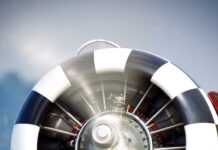In a letter sent to nearly 400 ICAS performer members late last week, ICAS urged air show performers to put safety at the top of their priority list as we enter the busiest part of the air show season. ICAS also asked these performers to demonstrate their commitment to safety by putting an ICAS or Safety First decal in a visible location on their aircraft.
The letter also identified a number of air show-specific safety concerns, including these reminders:
- Please recognize that nobody is immune from air show accidents. Air show flying can be dangerous, but it becomes much more dangerous when you begin flying with the idea that accidents only happen to “the other guy.”
- Fight complacency. If you find yourself becoming inattentive, find some way to maintain focus. The demands of air show flying do not permit you to become complacent…no matter how long you’ve been flying air shows.
- Be cautious during marginal weather conditions. When ceilings and visibility degrade, air show flying becomes exponentially more dangerous. Know your limits and then abide by those limits. Don’t let changes in weather push you into doing something you wouldn’t do otherwise.
- Be receptive to constructive criticism from your air show colleagues and be willing to offer constructive criticism yourself. If you’re not willing to both accept and offer critiques, we’re all doomed to make the same mistakes over and over again.
- We hope that you will lead by example. Your air show colleagues will pay more attention to what you do than what you say. Please take that responsibility seriously.
- Make the safe decision. Whether it’s getting home tomorrow instead of today or doing two snap rolls instead of three, make the safe decision.
- Be willing to stand down. It doesn’t matter if you’re angry, sick, distracted or otherwise not ready to fly. The show must go on and it will go on, but please be self-aware and humble enough to recognize that it can go on without you.
- Look after your own physiology. Stay hydrated. Eat well. Try not to be the last to leave the air show party. Be thoughtful about the medications you take. Build up your G tolerance through frequent practice sessions.
- Beware of turning props. Clearing the ramp of spectators when aircraft are moving under power is something that is done well at some shows and not so well at others. Be mindful that the ramp you’re taxiing on may not be sterile.
- Please approach the briefing with appropriate seriousness. The briefing is a time when possible problems are de-conflicted, but that can’t happen if you’re not paying attention.
- Whatever the stresses and strains of a particular show, be sure to give yourself not less than 30 minutes before your performance to mentally prepare for the rigors and demands of your upcoming performance without interruption or distraction.
- As we move into the hot weather portion of the season, please be aware of the additional stresses that high density altitude conditions can put on you and your aircraft.
- Don’t be in a rush to introduce mid-season changes to your aerobatic routine. The process of changing your maneuver sequence should be gradual and disciplined. Anything less becomes a safety hazard.
- Beware of cross country travel. A quick analysis of air show-related accidents during the past decade suggests that getting to and from air shows is one of the most dangerous parts of being an air show performer.








